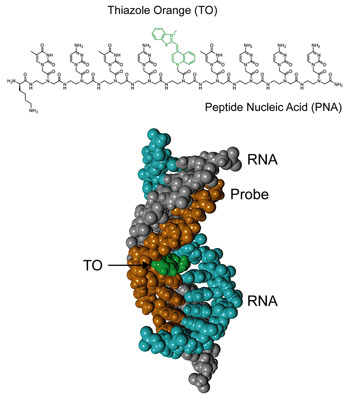Japanese Scientists Describe Powerful Fluorescent Probe for Studying RNA
By LabMedica International staff writers
Posted on 16 Aug 2016
A team of Japanese biochemists has described the development of a powerful new fluorescent probe for studying the structure and function of double stranded RNA (dsRNA).Posted on 16 Aug 2016
Investigators at Tohoku University (Sendai, Japan) created the probe by integrating the fluorescent dye thiazole orange (TO) as a base surrogate into triplex-forming PNA (peptide nucleic acid). PNAs are artificially synthesized polymers similar to DNA or RNA that were invented in 1991.

Image: The chemical structure of the probe, and the possible probe-dsRNA triplex structure (Photo courtesy of Tohoku University).
DNA and RNA have a deoxyribose and ribose sugar backbone, respectively, whereas PNA's backbone is composed of repeating N-(2-aminoethyl)-glycine units linked by peptide bonds. The various purine and pyrimidine bases are linked to the backbone by a methylene bridge (-CH2-) and a carbonyl group (-(C=O)-).
The investigators reported in the July 21, 2016, online edition of the Journal of the American Chemical Society that their probe formed a thermally stable triplex with the target dsRNA at acidic pH; and the triplex formation was accompanied by the remarkable light-up response of the TO unit. The binding of the probe to the target dsRNA proceeded very rapidly, allowing real-time monitoring of the triplex formation.
The TO base surrogate in the probe functioned as a universal base for the base pair opposite the TO unit in the triplex formation. Furthermore, the TO unit was significantly more responsive towards the fully matched dsRNA sequence compared to mismatch-containing sequences, which enabled the analysis of the target dsRNA sequence at single-base pair resolution.
The probe showed a striking preference for binding to dsRNA over dsDNA, which will be important in future applications in a cellular environment where RNA and DNA co-exist.
Related Links:
Tohoku University














